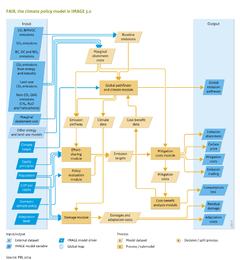Climate policy: Difference between revisions
Jump to navigation
Jump to search
No edit summary |
No edit summary |
||
| Line 6: | Line 6: | ||
|KeyReference=Den Elzen et al., 2011a; Den Elzen et al., 2008; Hof et al., 2008; Van Vliet et al., 2009; | |KeyReference=Den Elzen et al., 2011a; Den Elzen et al., 2008; Hof et al., 2008; Van Vliet et al., 2009; | ||
|InputVar=Population per Region; GDP per capita; CO2, other GHG, CO, NMVOC emissions; Marginal abatement cost; Climate policies; Marginal abatement cost; | |InputVar=Population per Region; GDP per capita; CO2, other GHG, CO, NMVOC emissions; Marginal abatement cost; Climate policies; Marginal abatement cost; | ||
|OutputVar= | |OutputVar=Access to food, water and energy; Child mortality; Life expectancy; Human Development Index (HDI); Millennium Development Goals (MDGs); | ||
|Description=In the United Nations climate negotiations, urgent action was called for to limit global warming to 2 °C. In order to achieve this climate goal, countries have proposed short- and long-term actions, both within the UNFCCC climate negotiating process and in domestic policies. To support climate policymakers, the IMAGE model is able to quantitatively evaluate and address different kinds of policy questions. For this, the IMAGE model is mostly used in conjunction with the FAIR model. The FAIR model is a decision-support tool to analyse the costs, benefits, and climate effects of mitigation regimes, emission reduction commitments, and climate policies. | |Description=In the United Nations climate negotiations, urgent action was called for to limit global warming to 2 °C. In order to achieve this climate goal, countries have proposed short- and long-term actions, both within the UNFCCC climate negotiating process and in domestic policies. To support climate policymakers, the IMAGE model is able to quantitatively evaluate and address different kinds of policy questions. For this, the IMAGE model is mostly used in conjunction with the FAIR model. The FAIR model is a decision-support tool to analyse the costs, benefits, and climate effects of mitigation regimes, emission reduction commitments, and climate policies. | ||
Revision as of 11:44, 9 December 2013
| Component is implemented in: |
|
| Related IMAGE components |
| Models/Databases |
| Key publications |
| References |
Key policy issues
- What global greenhouse gas emissions pathways would meet the well below 2 °C climate target?
- What is the effect of effort-sharing approaches on regional and national emission reduction targets and on the cost of climate policies?
- What is the effect of the NDCs on achieving the long term 2 ºC target?
- What are the trade-offs between mitigation costs, adaptation costs, and climate change damage?
